Introduction
In today’s business landscape, inclusivity extends far beyond mere diversity; it encompasses a strategic vision where every employee is actively engaged and valued. This enriched environment is not just an ethical choice but a business imperative that drives innovation and profitability. Studies show that inclusive companies are 1.7 times more likely to be innovation leaders in their market.

The diverse work settings in PepsiCo Food Office to address all empliyees’ requirements
Understanding Inclusivity
Inclusivity in the workplace means ensuring every employee feels genuinely valued and empowered. This includes providing physical accessibility, embracing cultural diversity, ensuring gender inclusivity, and supporting individuals with disabilities. According to McKinsey’s 2020 report, companies with diverse executive teams outperformed less diverse peers with a likelihood of 36% higher profitability.

Kimberly-Clark office designed & built by ADP
Challenges to Inclusivity
Creating an inclusive environment can be fraught with challenges. Unconscious biases, resistance to change, and a lack of awareness are significant barriers. For example, a Gallup poll highlighted that 45% of American workers experienced discrimination or harassment in the past year, reflecting broad challenges that can impact employee morale and productivity.
Strategies for Creating an Inclusive Workplace
1. Policy Development:
• Develop robust policies that set clear expectations for inclusivity. For instance, introducing anti-discrimination policies and equal opportunity measures is crucial.
• Ensure policies are inclusive, with companies like Microsoft seeing an increase in employee satisfaction by 50% after revamping their inclusivity policies.
2. Leadership and Training:
• Training leaders on inclusivity is vital. Google’s re:Work initiative shows that improved management practices increased team performance by 22%.
• Promoting leadership that values employee input can significantly affect morale and innovation.
3. Recruitment and Retention:
• Diverse recruitment strategies are essential. Companies with diverse staff have seen a 19% increase in revenue compared to their less diverse counterparts.
• Focusing on retention and inclusivity can reduce employee turnover by up to 50% in organizations that actively embrace diversity.
4. Culture and Communication:
• A culture that celebrates differences can enhance employee engagement and satisfaction. Companies that score in the top quartile of employee engagement outperform those in the bottom by over 200% in earnings per share.
• Effective communication strategies are crucial. Salesforce reported a 37% improvement in employee productivity after implementing inclusive communication practices.

The British American Tobacco Office in Vietnam designed & built by ADP to strengthen the inclusive culture
5. Feedback and Adaptation:
• Establish feedback mechanisms to continuously adapt inclusivity practices, with IBM reporting a 20% increase in employee performance after adopting continuous feedback systems.
Case Studies
Highlight companies like Accenture, which has successfully implemented inclusivity programs leading to a 27% increase in their workforce diversity over five years. Discuss strategies and outcomes to provide actionable insights for other businesses.
Conclusion
The imperative for inclusivity in the workplace is clear. It’s not only a moral imperative but a crucial business strategy that impacts all aspects of a company’s operations from productivity to profitability. By actively fostering an inclusive environment, businesses can unlock the full potential of their workforce



